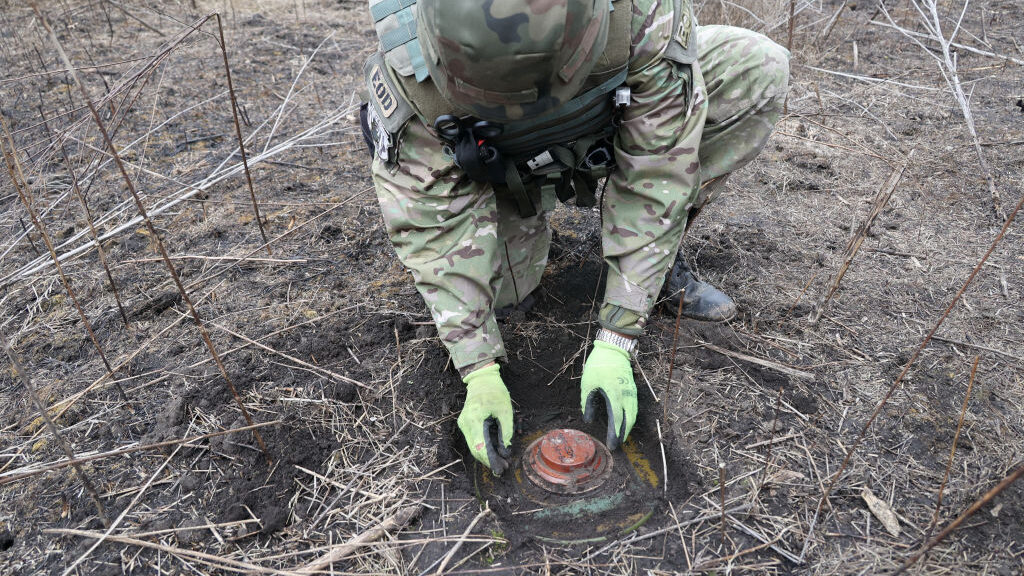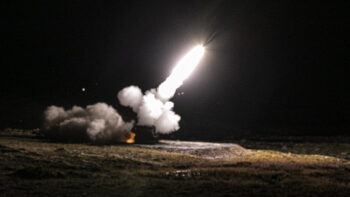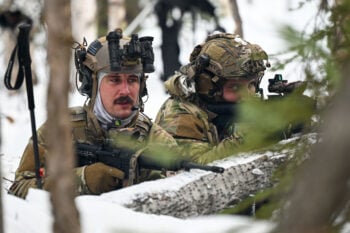
A sapper defuses an anti-tank mine as a consolidated squad of the Explosives Service of Ukraine carries out demining work in Kharkiv Region, northeastern Ukraine on Oct. 24, 2023. (Photo credit should read Vyacheslav Madiyevskyy / Ukrinform/Future Publishing via Getty Images)
WARSAW — As the war in Ukraine grinds on, the already monumental task of clearing the country of dangerous mines and unexploded ordinance is growing exponentially by the day, leading to what a senior industry official said will be the “biggest post-conflict challenge in the history of modern warfare.”
Henrik Faerch, CEO of the Danish de-mining firm Damasec Global Group, told Breaking Defense that the dangers to civilians in Ukraine “will be unlike any previous former battlezone.”
“It will be worse than Kuwait in 1991, worse than Angola, worse than Cambodia, worse than Afghanistan — even worse than the Balkans,” said Faerch, who is a former senior non-commissioned officer with a long career in the Danish armed forces.
Faerch and other company officials spoke to Breaking Defense at the Re-Build Ukraine exposition and conference in Warsaw, Poland, in November. The function of the event was to provide a venue for construction, energy, infrastructure and advanced materials companies to showcase their services to aid Kyiv in bouncing back from the devastation wrought by Russia’s invasion.
But before much of that work can be done, the country’s land must be made safe for civilians and workers, and that means securing countless hidden mines and other unexploded ordinance, also known as UXO.
“Every day of the conflict equals one month of UXO clearance,” one industry official said. The Ukrainian conflict has been going on more than 600 days at this point.
Unmapped Mines
Since Russia’s invasion in February 2022, both Ukraine and Russia have laid mines, but experts and independent observers have documented Russia’s prevailing use of both antipersonnel and anti-vehicular mines in an incredible volume.
The numbers and different models/designations of mines in Ukraine are almost unquantifiable at this point, but in April 2023 Ukraine Prime Minister Denys Shmyhal stated 174,000 square kilometers of Ukrainian territory — an area greater than the total landmass of Greece — is contaminated with mines and other UXO.
Extensive minefields have been identified in 11 of country’s 27 regions: Chernihivska, Dnipropetrovska, Donetska, Kharkivska, Khersonska, Kyivska, Luhanska, Mykolaivska, Odeska, Sumska and Zaporizka.
Moreover, the indiscriminate laying of mines by Russian forces is not a by-product only of the February 2022 invasion, but dates back to the occupation of Crimea and the invasion of the Donbas regions in 2014.
Both Ukraine and Russia inherited substantial stockpiles of mines leftover from the Soviet period, but there is a distinct difference in how they have deployed them. Ukraine is a signatory to the 1997 Mine Ban Treaty which proscribes the use of any anti-personnel mines, and its armed forces have largely refrained from employing any mines other than anti-vehicle models. However, Human Rights Watch has called out Ukraine forces for it described as “rocket-delivered PFM antipersonnel blast mines” during the battle for Izium in the summer of 2022.
Russia is not a signatory to this agreement, and its forces have deployed 13 types each of anti-personnel and anti-vehicle/anti-tank mines, with the hand-emplaced TM-62 series being the chief anti-vehicle model planted by Moscow’s forces, according to Human Rights Watch.
In August, Ukraine’s then-Defense Minister Oleksii Reznikov told the UK’s The Guardian newspaper that Ukraine was already by then the most mined country on earth. There are “hundreds of kilometers of minefields, millions of explosive devices, in some parts of the frontline up to five mines per square meter.”
The mines and unexploded devices are an obvious danger to civilians, but there’s been increasing indications that even mines laid by Russian forces have shown to be a danger to their own troops. In late November, a Ukrainian military spokesman claimed a Russian General Vladimir Zavadsky had been killed by stepping on what was presumed to be a Russian mine.
The next day the Ukraine General Staff said some Russian commanders were refusing to provide their own units with maps showing the locations of mines other forces had laid. Other reports claim maps of some Russian minefields that should permit their own forces to move through them safely are either inaccurate or do not even exist.
A lengthy report by Vox from the end of November points out Russian mines are being placed haphazardly on the battlefield, and explosive booby traps reportedly have been left in refrigerators or even in toys.
A lengthy investigation of Ukraine’s counteroffensive by The Washington Post found the fatal ubiquity of Russian mines as a key reason for Ukraine’s slow progress. In some areas, the paper said, Russian mines were so densely packed that there were mines on top of each other.
The Impossible Task of Removal
However they got there, it falls to Ukraine now to clear mines in territory they control, a daunting task.
Reznikov told The Guardian that Ukrainian armed forces have “skilled sappers and modern equipment, but they are extremely insufficient for the front that stretches hundreds of kilometers in the east and south of Ukraine.”
Pete Smith, Ukraine program manager of the mine-clearing NGO Halo, is also formerly the commanding officer of all the British army’s explosive ordnance disposal assets. He told the paper the level of mine contamination in Ukraine as “unrecognisable in modern history”.
“What we’re witnessing is the heaviest landmine and unexploded ordnance sort of contamination seen certainly in Europe since the second world war,” he continued. His estimate is even with an army of 10,000 mine clearers it would take a decade to decontaminate Ukraine.
Ukraine is getting help from its allies and partners, both governmental and non-governmental. The United Kingdom, for instance, reported in September that it had sent 1,500 mine detectors and mine clearance kits to Kyiv in 2023. The UK Ministry of Defence’s press release says the accompanying training program instructs Ukrainian sappers on how to “plan mine-disposal operations, and practical lessons on how to clear not only vast swathes of land, but also trench systems, bunkers and civilian buildings.” (The US has also included “mine clearing” equipment among the billions of dollars-worth of security assistance to Ukraine since Russia’s invasion.)
Meanwhile, Smith told The Guardian his NGO trained 900 sappers this past summer, though the organization was hoping to train 1,200 by then.
Damasac officials told Breaking Defense the company has established an office in Kyiv and is actively training local personnel in de-mining processes and techniques. But they echoed Halo’s concern over the lack of personnel.
“Sometimes we train up a group of new sappers and ready to be deployed — and then the Ukraine military comes along and tells them ‘you are all drafted,’ so we have to start all over,” one of their in-country experts told Breaking Defense. Other mine-clearing operators are discussing training only women for the future because “at least as of now, women are not being drafted in Ukraine.”
“Long after this war is over the UXO problem will still be around,” said Faerch. “We are still finding mines in western Europe left over from WWII and that was almost 80 years ago. So, you can only imagine in what century Ukraine might finally be free of this problem.”
Aloha: Fixes ongoing, then Army’s new watercraft prototype is Hawaii bound for testing
“Everything that we can knock off that list we will do in the archipelago…because that allows us to do the tests in the environment that the vessel will operate in ultimately,” said Maj. Gen. Jered Helwig.


























